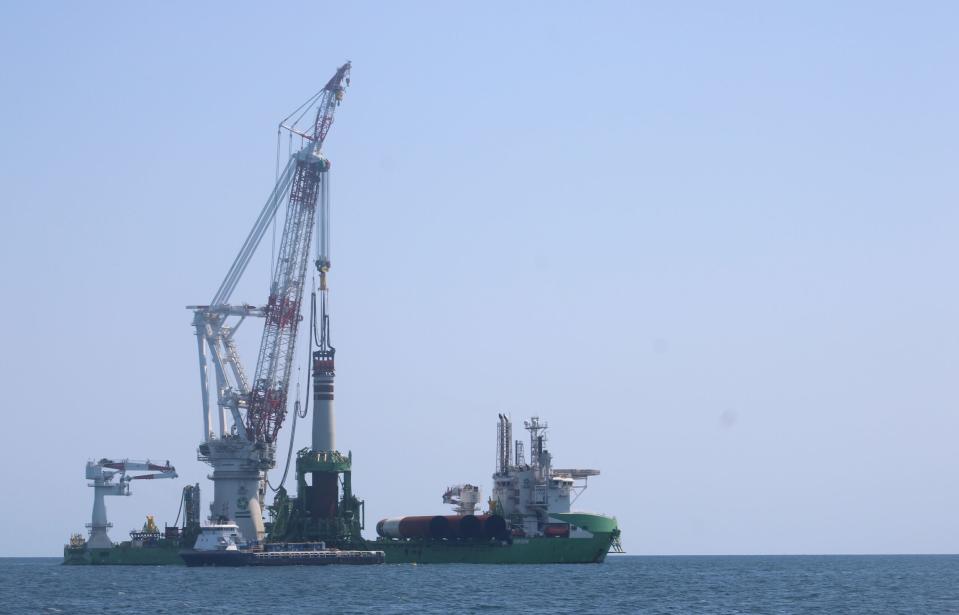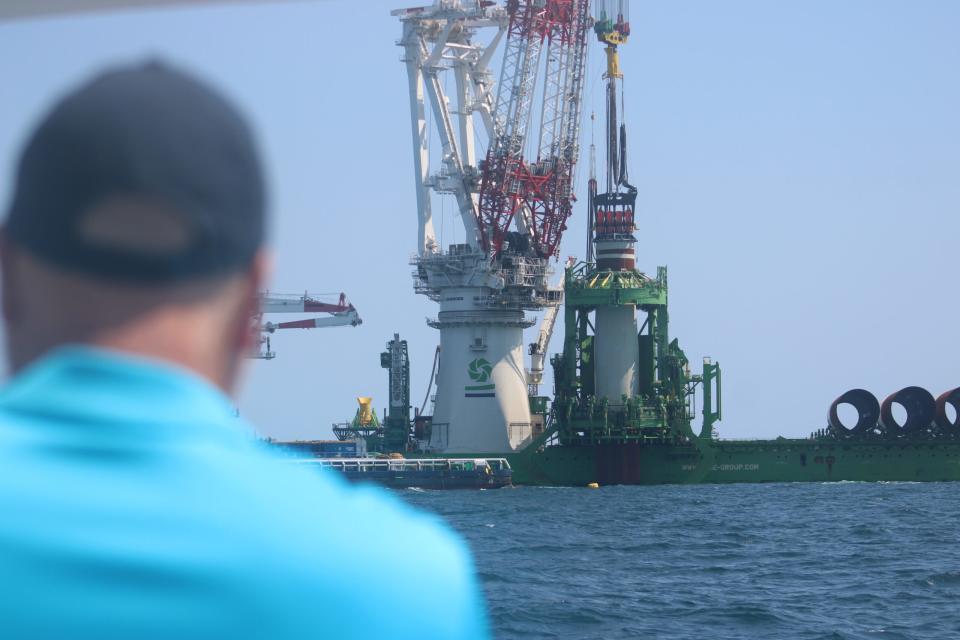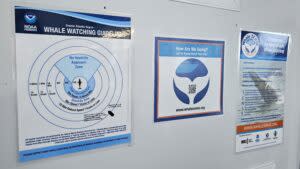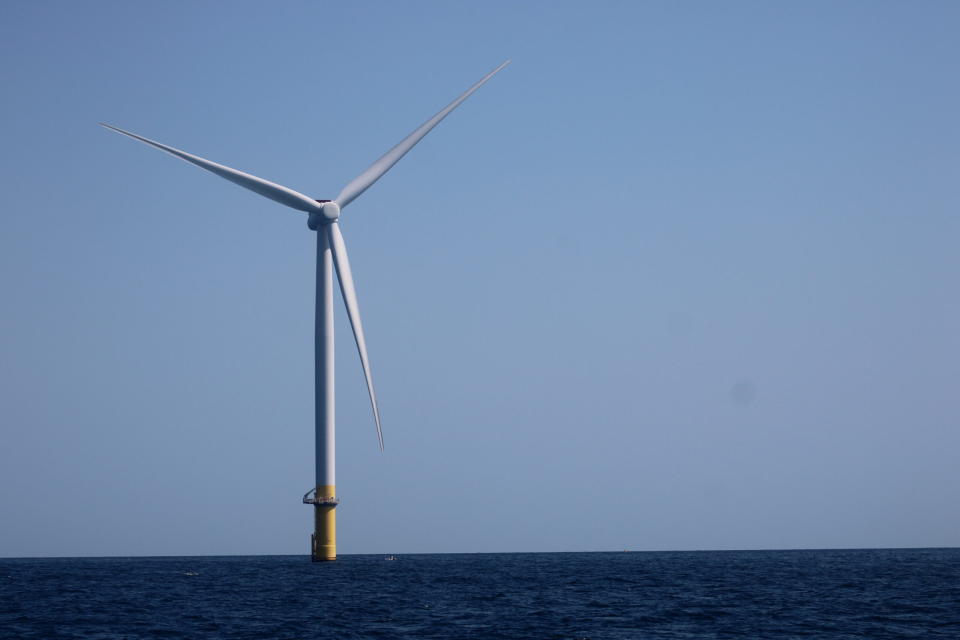As offshore wind installation rises, Dominion showcases environmental, economic benefits
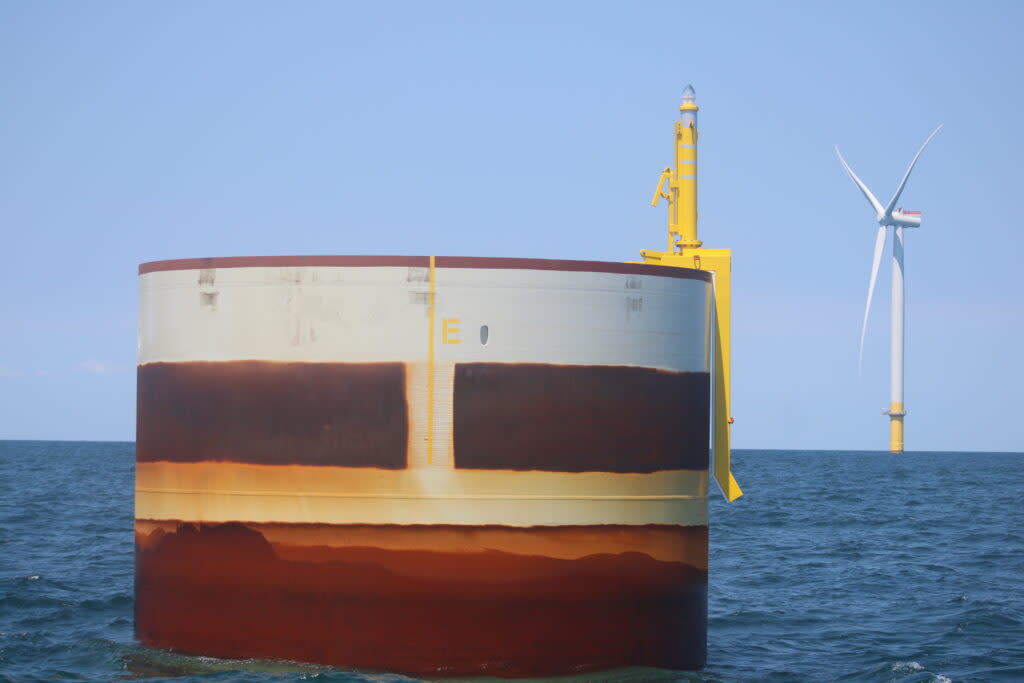
Monopiles that will be the base for wind turbines are being installed at Dominion's Coastal Virginia Offshore Wind Project. (Charlie Paullin/Virginia Mercury)
ATLANTIC OCEAN — On a recent summer day, under blue skies, a 272-feet tall, 31-feet wide, 1,500-ton steel cylinder was being pushed into the ocean floor 27 miles off the coast of Virginia Beach.
The process will be repeated for months as Dominion Energy builds the country’s largest offshore wind project.
“It’s really cool,” said John Larson, director of public policy and economic development for Dominion, who was watching the action from a boat about 1,600 feet away. “In your career, you don’t get to work on a lot of 10-year projects and actually see it happen.”
Larson and others involved in the $9.8 billion Coastal Virginia Offshore Wind project were showcasing the project’s construction and economic benefits while trying to allay environmental concerns during a tour of the work with area reporters.
The State Corporation Commission, Virginia’s utility regulators, approved the project seen as critical in the transition to renewable energy in the summer of 2022 as part of the Virginia Clean Economy Act, which requires the state’s two largest electricity utilities to decarbonize the grid by 2050.
The landmark law that passed in 2020, known as the VCEA, deemed Dominion’s 2.6 gigawatt project in the “public interest,” as the first step toward a requirement in the VCEA to ultimately produce 5.2 GW of electricity.
After about a decade of planning and federal and state permit review, construction of two pilot turbines and a legal hiccup from a lawsuit by conservative and fossil fuel funded groups, construction of the project’s 176 turbines began in May.
“Largest project Dominion’s ever done,” said Chris Nunn, director of engineering and onshore construction for the project, as he buzzed around the tour boat answering questions from reporters.
The project, scheduled to be completed in 2026, is expected to generate enough electricity to power 660,000 homes while avoiding the emissions of planet-warming greenhouse gasses equal to taking one million cars off the road.
The typical residential customer will pay about a $4 monthly fee over the 35-year lifespan of the turbines.
The construction
The giant cylinders, called monopiles, are carried six at a time to the site on the Orion, a vessel from the Belgium-based DEME group. The Orion uses a “gripper,” or a metal piece that curls around and grabs the tops of the monopiles like a hand, to raise the structures vertically and then push them 100 feet into the seafloor.
“That’s a big ol’ crane,” Larson said, his anti-sea sickness patch visible behind his ears. “They’ll switch the vibratory hammer head out and put in a pile driving hammer head. They’re pretty good at it. That’s what they do for a living. We plan to do one a day.”
Advantages to Virginia’s location is that the seafloor is sandy, instead of rocky or with boulders, allowing Orion to slowly push the monopile into the ground through vibrations before requiring some hammering for about 10 minutes in one instance.
“You have more control over the pile to vibrate it in for the majority,” said Mitchell Jabs, manager of environmental services for the project. “And then once you get to some of those harder layers where it’s deeper, you finish it with the impact pile driver.”
The 113,000-acre lease area of the wind farm, about the size of 85,000 football fields, is also about 50 miles short of the East Coast seafloor cliff that plummets about 3,000 feet deep. In deeper waters, floating technology for turbines is used, but here, where the ocean depth is about 85 feet, Nunn said that method was, “not cost effective.”
After the monopile is installed, yellow pieces that will transition the turbine from the monopile to the tower connecting up to the blades — the points of which will be 836 feet above the water — and other components are added. Those components are put together on land, and will be installed by Dominion’s construction vessel, Charybdis.
“It’ll bring four towers, four nacelles [or covers for the components] and four blades out at a time,” Larson said. “Then it will go back and get more. It has a big crane built on it.”
In addition to the turbines, there will be three five-story tall, 190-feet by 190-feet unmanned substations that will be monitored remotely, Nunn said. They’ll have welds and hatches like any other sea-faring vessel, but monopiles into the sea-floor will hold them in place.
“It has a technology called gas-inflated switchgear, so you can put it in a much smaller footprint [than a traditional substation] but it can handle higher voltages,” Nunn said.
The substations will draw in power from the the turbines before delivering the power back to shore through a connection of about 365-miles of 230 kilovolt export cable that will be buried 3 to 16 feet into the ground. Each export cable will have one slice, or connection point, while delivering the electrons to Virginia’s grid through the State Military Reservation area.
Maritime economy
Since the project was announced, Dominion has pointed to the economic benefits the region will see from the installation.
The company has spent about $700 million on the project in the United States, with about $526 million of that in Virginia. The jobs associated with the project include some 1,552 around the country, with about 800 in the state and about 670 in the Hampton Roads area.
Orion has a crew of members ranging from crane operators to ship-hands that will spend several days at a time on the water. Construction of the other components will include a crew of up to 30 people, working 14 days for 12-hour shifts, and then getting 14 days off.
“It takes a very unique individual to be out on those vessels for that period of time,” Nunn said. “A lot of the guys that we’re targeting are Navy guys, Coast Guard guys that are used to being at sea at a period of time.”
Environmental consideration
Despite those economic benefits and the environmental benefits of wind power, the project has raised concerns among people who point to disruptions for marine life.
The region is in the migratory path of the North Atlantic Right Whale, an endangered species, and also other mid-atlantic fish like the black sea bass.
Regulators with the Bureau of Ocean Energy Management outlined mitigation measures for Dominion to follow after a series of reviews. To address any impact to the right whale, Dominion must limit pile driving to between the months of May and October, when the whales aren’t migrating from their home in the Northeast. Monopile installation will then begin during the same period in 2025.
The company is also deploying a double bubble curtain created by an air filled hose that has perforations along it to send out compressed oxygen around the monopile as it’s put into the earth to absorb any noise from the pile driving.
“We saw it on the pilot project. We installed one pile without a double bubble curtain and we installed a second pile with a double bubble curtain,” said Jabs, over the hum of the tour boat making its way back to land. “They saw over a 10 decibel reduction. Underwater noise is measured on a logarithmic [or exponential] scale, so 10 decibels doesn’t sound like a lot but it’s really significant.”
There’s also buoys surrounding the construction vessel that sense if a whale or other fish species is in the area.
“We had one of the buoys go down and we weren’t able to pile drive because we’re not going to proceed without that,” Jabs said.
Protected Species Observers, or PSOs, are also on the vessels going to and from the site to spot anything swimming into the area and halt any activity. Pre-planning, to determine the GPS location of the monopiles, also discovered what habitats and abandoned ships were on the seafloor to avoid disturbing or running transmission cable through them.
Those abandoned ships and the two turbines built so far are wildlife habitat.
“Things grow on them, mussels, algae and then larger fish come in to eat on that, the bigger fish come in to eat off the bait fish,” said Jabs. “We’ve seen a real boom in black sea bass in the pilot program. It’s safe to say … they’ll start to build their own ecosystem.”
The Nature Conservancy is conducting research on the behavior of black sea bass during construction, which will provide an opportunity to learn for the offshore wind industry, Jabs said.
“I think the agencies paid a lot of attention to the data that we have, the data that we don’t have, where are the gaps to really frame up the mitigation and minimization measures,” she said. “It’s definitely uncharted territory, but I do think that [for] offshore wind as a whole, the environmental mitigations in place are very robust.”
The post As offshore wind installation rises, Dominion showcases environmental, economic benefits appeared first on Virginia Mercury.
